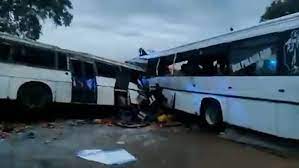An extremely gruesome road accident claimed nine lives and injured several others in central Senegal on Thursday, August 15.
Senegalese roads continue to be the scene of tragedies. This time it was a collision between a truck and a public transport bus that killed nine people and injured fifteen others near the village of Khourou Mbacké, in the central department of Diourbel.
Some of the victims belonged to the same family, including a physical education and sports teacher, as they were on their way to a funeral, according to sources who also indicated that the truck involved had a foreign license plate.
Six of the victims died on the spot, while the other three succumbed to their injuries after being taken to hospital, the national daily Le Soleil reported. The accident occurred a week before the Magal de Touba, a major religious gathering of the Mouride Sufi brotherhood that attracts hundreds of thousands of worshippers each year.
The tragedy comes just a week after an inter-ministerial council on road safety, chaired by Prime Minister Ousmane Sonko, was held in response to a series of dramatic accidents in Senegal in recent weeks. At the meeting, he pledged that from now on, clear lines of responsibility would be drawn after each accident and appropriate sanctions would be applied.
He also called for a “complete evaluation” by September 30 of the 22 measures adopted under the former regime of Macky Sall to tackle road accidents.
Sonko also insisted that the state must assume its responsibilities in the face of the recurrence of accidents. In addition to the human factor, obsolete vehicles and inadequate infrastructure, he sees corruption and lack of cooperation between the services concerned as the main causes of road tragedies in Senegal.
According to the National Road Safety Agency (ANASER), Senegal records an average of over 4,000 road accidents per year, including 745 deaths in 2019, or almost two deaths per day. These accidents are the leading cause of death among young people aged 15 to 24, and the second leading cause of death among those aged 25 to 39, after AIDS.
The ANASER also warns that the rapid urbanisation, increase in the number of vehicles and the youth of the population could aggravate this situation, particularly the most vulnerable road users.
ODL/ac/sf/lb/as/APA


